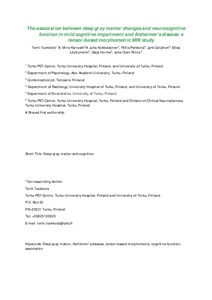Association between Deep Gray Matter Changes and Neurocognitive Function in Mild Cognitive Impairment and Alzheimer’s Disease: A Tensor-Based Morphometric MRI Study
Terhi Tuokkola; Mira Karrasch; Juha Koikkalainen; Riitta Parkkola; Jyrki Lötjönen; Eliisa Löyttyniemi; Saija Hurme; Juha Olavi Rinne
https://urn.fi/URN:NBN:fi-fe2021042826170
Tiivistelmä
Background Atrophy of deep gray matter (DGM) has been associated with a risk of conversion from
mild cognitive impairment (MCI) to Alzheimer’s disease (AD) and the degree of
cognitive impairment. However, specific knowledge of the associations between
degenerative DGM changes and neurocognitive functions remains scarce.
Objectives To examine degenerative DGM changes and evaluate their association with neurocognitive
functions.
Method We examined DGM volume changes with tensor-based morphometry (TBM) and analyzed
the relationships between DGM changes and neurocognitive functions in the control
(n =58), MCI (n = 38) and AD (n = 58) groups with multiple linear regression analyses.
Results In all DGM areas, the AD group had the largest TBM volume changes. The differences
in TBM volume changes were larger between the control group and the AD group
than between the other pairs of groups. In the AD group, volume changes of the
right thalamus were significantly associated with episodic memory, learning and
semantic processing. Significant or trend-level associations were identified
between the bilateral caudate nucleus changes and episodic memory as well as
semantic processing. In the control and MCI groups, very few significant associations
emerged.
Conclusions Atrophy of the DGM structures, especially the thalamus and caudate nucleus is related
to cognitive impairment in AD. DGM atrophy is associated with tests reflecting
both subcortical and cortical cognitive functions.
Kokoelmat
- Rinnakkaistallenteet [27094]
